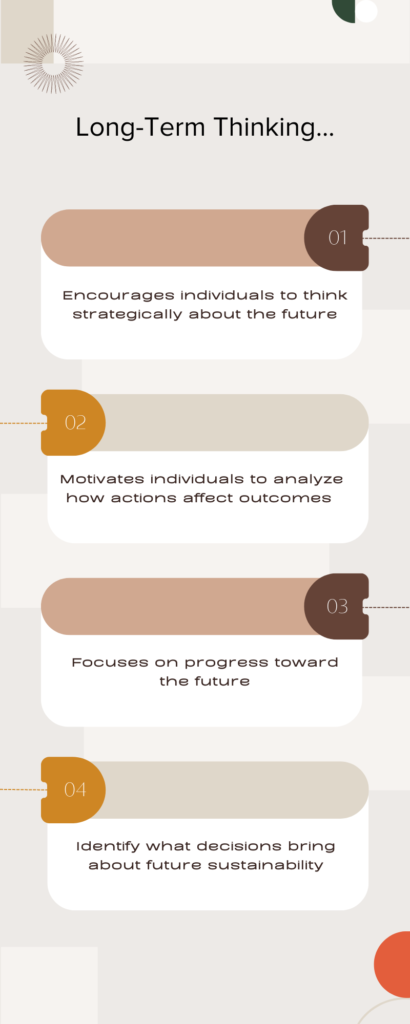By: Felecia Brasfield
As situations or issues arise, it’s natural for people to try and find an immediate solution. Finding an immediate payoff or resolution seems much more favorable than being patient and waiting for more significant gains in the distant future. While short-term solutions produce immediate benefits, they can lay the foundation for poor leadership. Short-term thinking may lead to sub-par decision-making or the ability to make a decision altogether. However, encouraging long-term thinking in employees provides more stability and a more robust workforce for organizations.
What is Long-Term Thinking?
Simply put, long-term thinking means considering what might happen in the future and what choices affect the outcome, both positively and negatively.

Always Think Long-Term
Shifting the focus to long-term thinking benefits individual workers and the entire company.
Sets a Foundation of Knowledge & Experience
Employees who have been part of the company for an extended time have a wealth of knowledge regarding many aspects of the business. They usually have a solid understanding of the company’s culture, vision, and long-term goals. Also, workers with more extended periods of employment often gain in-depth knowledge of various departments and job functions.
Indicates a Stable Workforce
Long-term thinking in employees is likely to produce workers who stay for years. If companies have lower employee turnover, it communicates a stable workforce. When workers leave a company, it disorders the environment.
Fosters Mentorship
Employees who have been on board for a long time create an invaluable support system for newer employees. Long-term workers provide great options for mentor-mentee relationships too.
Builds Trust within the Company
Leadership that communicates openly and executes strategies well illustrates to employees where the company is heading. It also guides workers on how progress will be monitored and builds trust.
How to Prioritize Long-Term Thinking
Several things can be done on an individual and organizational level to get employees to think long-term.
Need To Fill Roles At Your Company?
Fill Out Our Employee Request Form
1. Develop a Roadmap
It’s necessary to craft a detailed plan to instill long-term thinking. A few things are needed to include any financial allocations needed, individuals or departments involved, and a timeline with dates. For change to occur, the roadmap needs to address aspects of the business impacted to support the new plan.
2. Keep Employees Informed
One way to encourage employees to think long-term is to keep them in the loop! Once a detailed plan has been developed, focus on communicating any changes that will occur. Be as transparent as possible. Businesses that keep their workforce informed are stimulating long-term strategic thinking.
3. Embrace Empathy
Being a strong leader means being able to relate to direct reports, which requires empathy. The Center for Creative Leadership found that empathy is directly tied to job performance. The study shows that leaders who expressed empathy were ranked as better supervisors by direct reports and better employees by bosses.
4. Acknowledge Employee Success
Employees involved in long-term planning are more likely to share ideas and work to get them in place. As workers contribute contributions, finding ways to acknowledge them gives them a boost of confidence and recognition.
5. Adopt Efficient Time Management Skills
Poor time management skills lead to procrastination and inability to focus. Long-term thinking is much less likely if employees aren’t focused or applying themselves. However, managers can add value to an employee’s experience by helping each person set weekly, monthly, or yearly goals. A plan on reaching short-term goals eventually turns into accomplishing long-term goals.
6. Establish Team Building Activities
Team building activities are important for employees at every level of the organization, regardless of the company’s size. Team building allows workers to form bonds and develop stronger intra-work relationships. It also helps co-workers understand each other’s thinking processes and team up easier.
7. Consider Non-Monetary Rewards
While money is a great motivator, it’s not the only appreciated reward. Incorporating other methods helps employees seek unique perspectives and strategies to garner other benefits. These could include leaving work early, volunteering while on the clock, or allowing time in other departments to gain new skills.
8. Scout Out Diverse Perspectives
Managers don’t have all the answers and can’t always solve problems, especially without help. Seeking out input from several employees helps generate more ideas and different solution options. Bring together workers from various departments to brainstorm all the possible outcomes and opportunities for getting there.
9. Focus on Solutions
Guide employees to consider long-term solutions instead of short-term fixes. This shift in focus might prevent the same issue from occurring again. Ask employees to evaluate all possible outcomes before deciding.
Beyond the Benefits
Putting measures in place to build long-term thinking in employees can potentially transform the company for the better. Guide workers to think strategically and be enthusiastic about the company’s future. Remember to lead by example and be forward-thinking about the organization.


Leave a Reply